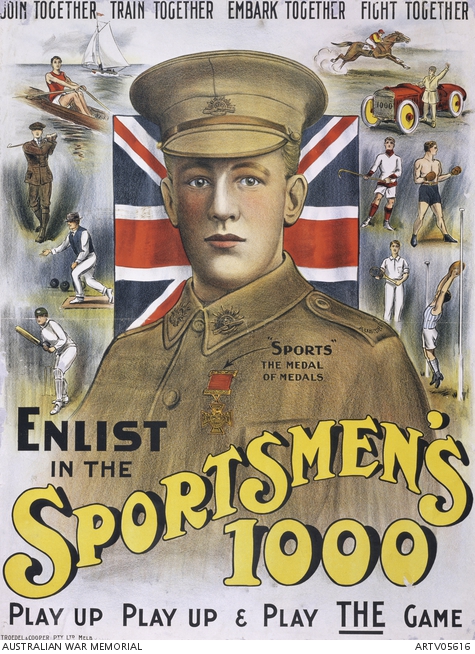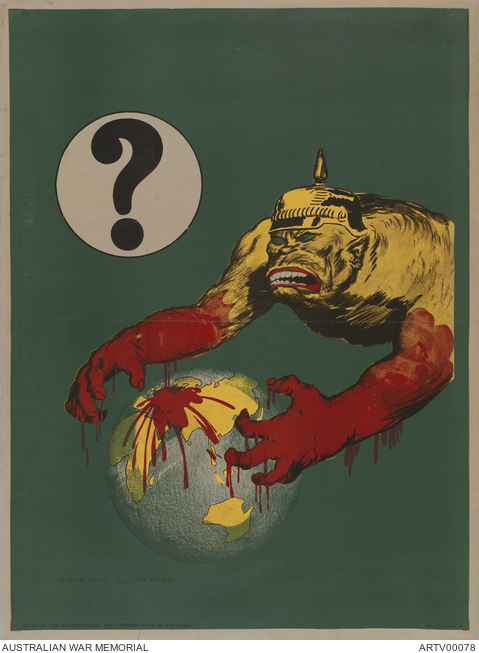Propaganda posters
Propaganda is a form of communication that promotes a particular perspective or agenda by using text and images to provoke an emotional response and influence behaviour.
Can you think of some modern examples of propaganda?
1. During the First World War, propaganda was used around the world for fundraising, to build hatred of the enemy, and to encourage enlistment. Posters were an ideal method of communicating this propaganda, as they could be printed and distributed quickly in large quantities.
Here are two examples of Australian propaganda posters, which aimed to encourage enlistment by promoting a sense of comradery and duty:
Sportsmens’ Recruiting Committee, Troedel and Cooper Pty. Ltd, Enlist in the Sportsmens’ 1000, 1917, chromolithograph on paper, 98.7 x 73.2 cm
David Souter, Win the War League, William Brooks and Co. Ltd, It is nice in the surf, but what about the men in the trenches?, 1915, lithograph printed in colour on paper, 76.2 x 51.4 cm
a. What messages are the posters presenting?
b. Who are those posters targeting? Who are they not targeting, and why?
c.What do these posters tell us about how the typical Australian man was percieved during the early 1900s?
d. Do you think these posters would have influenced people like Augusta Enberg, the Christensen family, or Peter Rados? Why or why not?
2. The following propaganda posters also encouraged enlistment, but did this by building fear of the enemy.
Norman Lindsay, Commonwealth Government of Australia Syd. Day, The Printer Ltd, ?, 1918, chromolithograph on paper, 99 x 74.4 cm
B.E. Pike, VAP Service, Must it come to this?, 1914 – 1918, chromolithograph on paper, 57.7 x 46 cm
Norman Lindsay, Commonwealth Government of Australia, W.E. Smith Ltd, Will you fight now or wait for this?, 1918, chromolithograph on paper, 98.3 x 74.6 cm
a. How is the enemy depicted, and what message is being presented?
b. How does the artist use text and images to convey this message?
c. What mood is being created?
d. What design elements (colour, typography, shape, space, and scale) have contributed to the mood of this poster?
e. Do you think the artist has been successful in getting their messages across? Why or why not?
f. How do you think these posters might have made Australians with German heritage feel?
3. Below are German propaganda posters that also focus on the notion of the enemy.
Claus Berthold, Das Duetsche Scharfe Schwert [The German sharp sword], 1917, lithograph on paper, 90.8 x 58 cm
Leopold von Kalckreuth, Hurrah, Alle Neune [Hurrah, all nine!], 1918, lithograph printed in colour, 75.4 x 57 cm
Egon Tschirch Was England Will! [What England will do!...], 1918, lithograph printed in colour, 93 x 67cm
a. Translate the text on these posters using Google Translate. You can also find out more about the posters by searching with the image number (such as ARTV10346) at www.awm.gov.au
b. Compare and contrast these three German posters, to the three Australian posters that also focus on the enemy. Identify similarities and differences relating to message, tone, and the representation of the opposing side. Which posters do you think have the greatest impact? Why?
4. Design your own First World War propaganda poster. You might like to consider:
a. Will you use an Australian, British, German, French or other perspective?
b. What are you trying to get the viewer to think or feel?
c. Will your message be positive or negative?
d. What colours, font, size, and style will you use to get your message across?
For more images and activities relating to propaganda posters from the First and Second World Wars, view the Hearts and Minds education kit.







